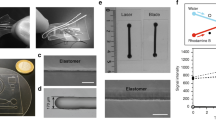Abstract
Studying the dynamics of intracellular processes and investigating the interaction of individual macromolecules in live cells is one of the main objectives of cell biology. These macromolecules move, assemble, disassemble, and reorganize themselves in distinct manners under specific physiological conditions throughout the cell cycle. Therefore, in vivo experimental methods that enable the study of individual molecules inside cells at controlled culturing conditions have proved to be powerful tools to obtain insights into the molecular roles of these macromolecules and how their individual behavior influence cell physiology. The importance of controlled experimental conditions is enhanced when the investigated phenomenon covers long time periods, or perhaps multiple cell cycles. An example is the detection and quantification of proteins during bacterial DNA replication. Wide-field microscopy combined with microfluidics is a suitable technique for this. During fluorescence experiments, microfluidics offer well-defined cellular orientation and immobilization, flow and medium interchangeability, and high-throughput long-term experimentation of cells. Here we present a protocol for the combined use of wide-field microscopy and microfluidics for the study of proteins of the Escherichia coli DNA replication process. We discuss the preparation and application of a microfluidic device, data acquisition steps, and image analysis procedures to determine the stoichiometry and dynamics of a replisome component throughout the cell cycle of live bacterial cells.
Similar content being viewed by others
References
Huang B, Bates M, Zhuang X (2009) Super-resolution fluorescence microscopy. Annu Rev Biochem 78(1):993–1016. doi:10.1146/annurev.biochem.77.061906.092014
Schermelleh L, Heintzmann R, Leonhardt H (2010) A guide to super-resolution fluorescence microscopy. J Cell Biol 190(2):165–175. doi:10.1083/jcb.201002018
Moolman MC, Krishnan ST, Kerssemakers JWJ, van den Berg A, Tulinski P, Depken M et al (2014) Slow unloading leads to DNA-bound ß2-sliding clamp accumulation in live Escherichia coli cells. Nat Commun 5:5820. doi:10.1038/ncomms6820
Joyce G, Robertson BD, Williams KJ (2011) A modified agar pad method for mycobacterial live-cell imaging. BMC Res Notes 4:73. doi:10.1186/1756-0500-4-73
Sia SK, Whitesides GM (2003) Microfluidic devices fabricated in poly(dimethylsiloxane) for biological studies. Electrophoresis 24(21):3563–3576. doi:10.1002/elps.200305584
Microfluidic foundry company website: http://www.microfluidicfoundry.com/moldpdms.html
Moolman MC, Dekker NH, Kerssemakers JWJ, Krishnan ST, Huang Z (2013) Electron beam fabrication of a microfluidic device for studying submicron-scale bacteria. J Nanobiotechnol 11:1–10
Grünwald D, Shenoy SM, Burke S, Singer RH (2008) Calibrating excitation light fluxes for quantitative light microscopy in cell biology. Nat Protoc 3(11):1809–1814. doi:10.1038/nprot.2008.180
Hines KE (2013) Inferring subunit stoichiometry from single-molecule photobleaching. J Gen Physiol 141(6):737–746. doi:10.1085/jgp.201310988
Reyes-Lamothe R, Sherratt DJ, Leake MC (2010) Stoichiometry and architecture of active DNA replication machinery in Escherichia coli. Science 328:498–501
Acknowledgments
The authors would like to thank the members of the Nynke H. Dekker laboratory for discussions on the chapter. We thank Sriram T. Krishnan for his active involvement in the experiments discussed here, Jacob W.J. Kerssemakers for contributing to the development of the data analysis procedures, and Margreet Doctor for building and maintaining the experimental setup. The experiments described here were carried out in the Department of Bionanoscience, Delft University of Technology.
Author information
Authors and Affiliations
Corresponding author
Editor information
Editors and Affiliations
Rights and permissions
Copyright information
© 2017 Springer Science+Business Media LLC
About this protocol
Cite this protocol
de Leeuw, R., Brazda, P., Charl Moolman, M., Kerssemakers, J.W.J., Solano, B., Dekker, N.H. (2017). Measuring In Vivo Protein Dynamics Throughout the Cell Cycle Using Microfluidics. In: Espéli, O. (eds) The Bacterial Nucleoid. Methods in Molecular Biology, vol 1624. Humana Press, New York, NY. https://doi.org/10.1007/978-1-4939-7098-8_18
Download citation
DOI: https://doi.org/10.1007/978-1-4939-7098-8_18
Published:
Publisher Name: Humana Press, New York, NY
Print ISBN: 978-1-4939-7097-1
Online ISBN: 978-1-4939-7098-8
eBook Packages: Springer Protocols




